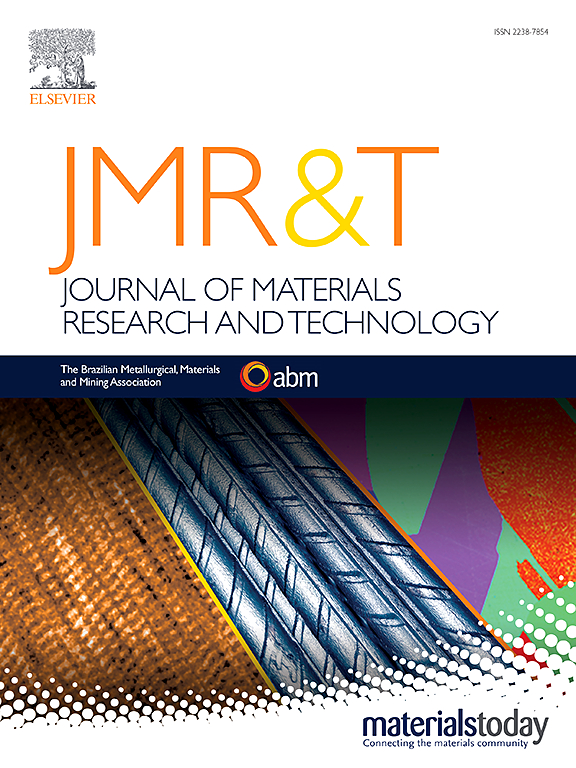Bond damage evolution and spatial micro-mechanism analysis of corroded reinforced concrete and failure mode assessment by acoustic emission
IF 6.6
2区 材料科学
Q1 MATERIALS SCIENCE, MULTIDISCIPLINARY
Journal of Materials Research and Technology-Jmr&t
Pub Date : 2025-06-11
DOI:10.1016/j.jmrt.2025.06.068
引用次数: 0
Abstract
Bond performance is an important guarantee for the structural integrity and long-term service performance of reinforced concrete, which is seriously threatened by the reinforcing bar corrosion in corrosive environments. This study employs an experimental framework combining macroscopic pull-out test, microscopic scanning electron microscopy (SEM), microscopic X-ray photoelectron spectroscopy (XPS), and acoustic emission (AE) monitoring to investigate bond behavior evolution in corroded reinforced concrete with HRB400 ribbed reinforcing bar. Pull-out tests were conducted on specimens with varying corrosion extents (CE: 0 %, 3 %, 5 %, 8 %), complemented by SEM-XPS to elucidate spatial micro-mechanisms. AE technology was employed to monitor real-time damage progression, with Mel-frequency cepstral coefficients (MFCC) enabling precise segmentation of bond damage stages. Based on MFCC segmentation, the bond failure stages and modes are quantitatively classified by leveraging RA-AF values and Gaussian mixture model (GMM) clustering. Results revealed a 24.2 % decline in bond strength at CE = 8 % compared to uncorroded specimens, accompanied by a transition in failure modes from splitting to hybrid splitting-pull-out debonding. Low corrosion (≤3 %) enhances initial friction with ductile failure via rust compaction, while higher corrosion (≥5 %) causes abrupt brittle failure due to corrosion-induced cracking that degrades bond integrity. Microscopic characterization analysis showed that corrosion products (e.g., porous FeO and brittle Fe(OH)3) reduced mechanical interlock, while microcrack propagation and stress redistribution accelerated interfacial debonding. The bond-slip process was quantitatively divided into four stages using MFCC analysis, in which higher CE values led to the disappearance of some stages. GMM clustering of RA-AF values successfully differentiated shear-dominated (low CE) and tensile-shear mixed (high CE) failure modes. Based on Pearson correlation coefficient, an established predictive model for bond behavior demonstrated high accuracy (R2 > 0.9) in predicting bond strength and slip. This study bridges multi-scale mechanisms, providing some references for durability assessment and maintenance strategies of corrosion-affected reinforced concrete infrastructure.
腐蚀钢筋混凝土粘结损伤演化与空间细观机制分析及声发射破坏模式评估
粘结性能是钢筋混凝土结构完整性和长期使用性能的重要保证,在腐蚀环境中钢筋腐蚀严重威胁钢筋混凝土的结构完整性和长期使用性能。本研究采用宏观拉拔试验、微观扫描电镜(SEM)、微观x射线光电子能谱(XPS)和声发射(AE)监测相结合的实验框架,研究了HRB400肋钢筋腐蚀钢筋混凝土的粘结行为演变。在不同腐蚀程度(CE: 0%, 3%, 5%, 8%)的试样上进行了拔出试验,并辅以SEM-XPS来阐明空间微观机制。AE技术用于实时监测损伤进展,mel频率倒谱系数(MFCC)可以精确分割粘结损伤阶段。在MFCC分割的基础上,利用RA-AF值和高斯混合模型(GMM)聚类对键合失效阶段和模式进行定量分类。结果显示,在CE = 8%时,与未腐蚀的试样相比,粘结强度下降了24.2%,同时破坏模式从劈裂过渡到混合劈裂-拉出脱粘。低腐蚀(≤3%)会增强初始摩擦,并通过锈蚀压实导致延性破坏,而高腐蚀(≥5%)会导致突然的脆性破坏,这是由于腐蚀引起的开裂,从而降低了粘结的完整性。微观表征分析表明,腐蚀产物(如多孔FeO和脆性Fe(OH)3)减少了机械联锁,而微裂纹扩展和应力重分布加速了界面脱粘。通过MFCC分析,将粘结滑移过程定量分为4个阶段,其中CE值越高,部分阶段消失。RA-AF值的GMM聚类成功区分了剪切主导(低CE)和拉伸-剪切混合(高CE)破坏模式。基于Pearson相关系数,建立的键行为预测模型具有较高的准确性(R2 >;0.9)用于预测粘结强度和滑移。本研究跨越了多尺度机制,为钢筋混凝土基础设施的耐久性评估和维护策略提供了一些参考。
本文章由计算机程序翻译,如有差异,请以英文原文为准。
求助全文
约1分钟内获得全文
求助全文
来源期刊

Journal of Materials Research and Technology-Jmr&t
Materials Science-Metals and Alloys
CiteScore
8.80
自引率
9.40%
发文量
1877
审稿时长
35 days
期刊介绍:
The Journal of Materials Research and Technology is a publication of ABM - Brazilian Metallurgical, Materials and Mining Association - and publishes four issues per year also with a free version online (www.jmrt.com.br). The journal provides an international medium for the publication of theoretical and experimental studies related to Metallurgy, Materials and Minerals research and technology. Appropriate submissions to the Journal of Materials Research and Technology should include scientific and/or engineering factors which affect processes and products in the Metallurgy, Materials and Mining areas.
 求助内容:
求助内容: 应助结果提醒方式:
应助结果提醒方式:


